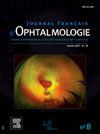Comparative efficacy of two different subthreshold yellow laser treatments for chronic central serous chorioretinopathy
IF 1.1
4区 医学
Q3 OPHTHALMOLOGY
引用次数: 0
Abstract
Purpose
To investigate and compare the anatomic and functional outcomes in patients with chronic central serous chorioretinopathy (cCSC) who have undergone subthreshold laser therapy using either the Navigated Microsecond Laser (nMSL) or Endpoint Management™ (EpM) system.
Methods
This retrospective study evaluated 80 eyes (78 patients) with cCSC. Patients were divided into two groups: nMSL treatment (n = 39, group 1) and the EpM procedure (n = 41, group 2). The primary outcomes at 6 months were changes in best-corrected visual acuity (BCVA) and central macular thickness (CMT), along with the rate of complete subretinal fluid (SRF) resolution.
Results
Group 1 demonstrated a significantly greater improvement in BCVA compared to group 2 at both 3 and 6 months post-treatment (P = 0.006 and P = 0.013, respectively). Both groups exhibited a statistically significant decrease in mean CMT. At 6 months, a higher proportion of patients in group 1 achieved complete resolution of SRF compared to group 2 (76.9% vs. 61.0%).
Conclusion
According to our findings, navigated MSL is highly effective in terms of visual outcomes and retinal morphology. EpM is also effective in decreasing SRF in cCSC patients. In cCSC patients, nMSL therapy may be a more effective and safe approach for restoring macular anatomy and visual outcomes than EpM.
Objet
Étudier et comparer les résultats anatomiques et fonctionnels de patients atteints de choriorétinopathie séreuse centrale chronique, ayant subi une thérapie au laser sous-seuil avec soit le laser à microsecondes navigué, soit le système Endpoint Management™.
Méthodes
Cette étude rétrospective a évalué 80 yeux (78 patients) atteints de choriorétinopathie séreuse centrale chronique. Les patients ont été divisés en deux groupes : le premier a eu un traitement au laser microseconde navigué (n = 39, groupe 1) et le second a utilisé la procédure Endpoint Management™ (n = 41, groupe 2). Les principaux résultats à 6 mois comprenaient les changements dans la meilleure acuité visuelle corrigée, l’épaisseur maculaire centrale, ainsi que le taux de résolution complète du liquide sous-rétinien.
Résultats
Le groupe 1 a montré une amélioration significativement plus importante de la meilleure acuité visuelle corrigée par rapport au groupe 2, tant à 3 qu’à 6 mois après le traitement (p = 0,006 et p = 0,013, respectivement). Les deux groupes ont présenté une diminution statistiquement significative de l’épaisseur maculaire centrale moyenne. À 6 mois, une proportion plus élevée de patients du groupe 1 a obtenu une résolution complète du liquide sous-rétinien par rapport au groupe 2 (76,9 % contre 61,0 %).
Conclusion
D’après nos résultats, le laser microseconde navigué est très efficace pour les résultats visuels et la morphologie de la rétine. Endpoint Management™ est également efficace pour diminuer le liquide sous-rétinien chez les patients atteints de choriorétinopathie séreuse centrale chronique. Chez les patients atteints de choriorétinopathie séreuse centrale chronique, la thérapie au laser microseconde navigué peut constituer une approche plus efficace et plus sûre pour restaurer l’anatomie maculaire et les résultats visuels que le Endpoint Management™.
两种阈下黄色激光治疗慢性中枢性浆液性脉络膜视网膜病变的疗效比较
目的研究和比较使用导航微秒激光(nMSL)或终点管理™(EpM)系统接受阈下激光治疗的慢性中枢性浆液性脉络膜视网膜病变(cCSC)患者的解剖和功能结果。方法回顾性研究80眼(78例)cCSC。患者分为两组:nMSL治疗组(n = 39,组1)和EpM治疗组(n = 41,组2)。6个月时的主要结果是最佳矫正视力(BCVA)和中央黄斑厚度(CMT)的变化,以及视网膜下液(SRF)完全解析率的变化。结果治疗后3个月和6个月,治疗组1的BCVA改善明显高于治疗组2 (P = 0.006和P = 0.013)。两组患者的平均CMT均有统计学意义的下降。6个月时,与2组相比,1组患者完全缓解SRF的比例更高(76.9%对61.0%)。结论在视觉效果和视网膜形态方面,导航式MSL是非常有效的。EpM对降低cCSC患者的SRF也有效。在cCSC患者中,nMSL治疗可能是比EpM更有效和安全的恢复黄斑解剖和视力结果的方法。ObjetÉtudier等比较了不同年龄的患者的生理结构和功能,比较了不同年龄的患者的生理结构,比较了不同年龄的患者,比较了不同年龄的患者,比较了不同年龄的患者,比较了不同年龄的患者,比较了不同年龄的患者,比较了不同年龄的患者。80岁(78例)的患者,曾尝试过慢性、中心性和变性的治疗。将6例患者分为两组:第一组采用激光微秒导航治疗(n = 39,组1),第二组采用激光微秒导航治疗(n = 41,组2)。3 .关于修正的主要因素:修正的主要因素:修正的主要因素:修正的主要因素:修正的主要因素:修正的主要因素:修正的主要因素:修正的主要因素:修正的主要因素:修正的主要因素:修正的主要因素:修正的主要因素:修正的主要因素:修正的主要因素:修正的主要因素:修正的主要因素:修正的主要因素:修正的主要因素:修正的主要因素:修正的主要因素:ResultatsLe groupe 1看一个改良重要+重要de la中acuite visuelle corrigee par融洽盟groupe 2,如此更瞿3萨那6月然后le traitement (p = 0006 et p = 0013, respectivement)。两个组的数据表明,在中央moyenne的数据中,有显著的减少。À 6 mois, 1组患者有1个比例的合并患者有1个比例的合并患者有1个比例的合并患者有1个比例的合并患者有1个比例的合并患者有1个比例的合并患者有1个比例的合并患者(76,9 %对61,0 %)。结论采用激光微秒导航技术,研究了激光微秒导航技术在治疗视网膜病变中的应用效果。终点管理(Endpoint Management™)测试了较低的液体性变性和较低的慢性青光膜变性和中心性慢性青光膜变性患者的变性效果。在病人atteints de chorioretinopathie sereuse舟状骨chronique, la therapie盟激光microseconde navigue可以具一个approche + efficace等确定倒restaurer l 'anatomie maculaire等时候visuels缆车端点管理™。
本文章由计算机程序翻译,如有差异,请以英文原文为准。
求助全文
约1分钟内获得全文
求助全文
来源期刊
CiteScore
1.10
自引率
8.30%
发文量
317
审稿时长
49 days
期刊介绍:
The Journal français d''ophtalmologie, official publication of the French Society of Ophthalmology, serves the French Speaking Community by publishing excellent research articles, communications of the French Society of Ophthalmology, in-depth reviews, position papers, letters received by the editor and a rich image bank in each issue. The scientific quality is guaranteed through unbiased peer-review, and the journal is member of the Committee of Publication Ethics (COPE). The editors strongly discourage editorial misconduct and in particular if duplicative text from published sources is identified without proper citation, the submission will not be considered for peer review and returned to the authors or immediately rejected.

 求助内容:
求助内容: 应助结果提醒方式:
应助结果提醒方式:


